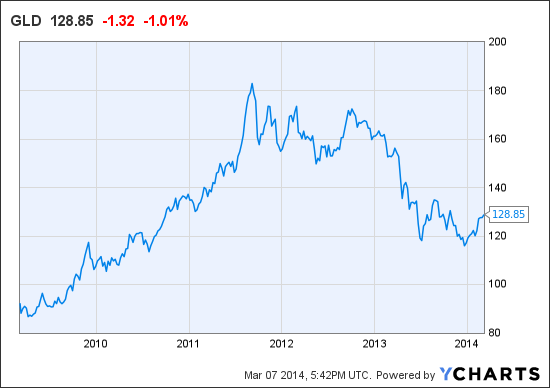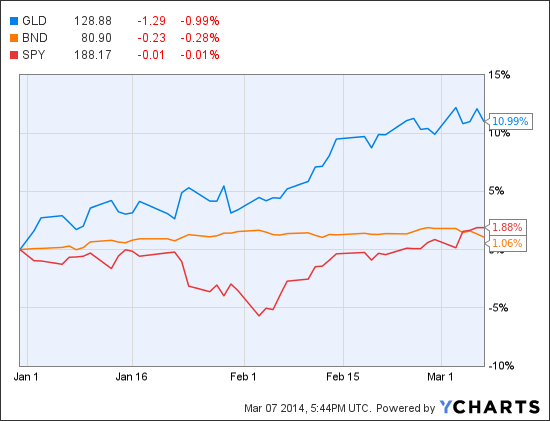A Few Reasons To Be Bullish On Gold
Summary
- Gold has been the best performing asset year-to-date.
- China and Russia continue to amass huge quantities of physical gold.
- Banks that are short gold are being forced to close their positions due to Fed taper resulting in a short squeeze.
- The U.S. currency is the reserve currency mostly because of the petrodollar standard.
- Russia has threatened to leave the petrodollar standard and dump its Treasury holdings due to the current events in the Ukraine.
There have been several geopolitical developments over the past few months which lend significant support to the arguments of gold bulls. The market has begun to recognize some of these developments as evidenced by gold being the best performing asset this year. However, Wall Street largely disagrees as evidenced by a recent Bank of America (BAC) recommendation to sell gold.
Wall Street's pessimism appears to be poorly placed in my view, given these recent developments. Three of these developments will be the primary focus of this article.
Many gold bulls are well aware of the fact that China and India have been stockpiling gold in recent years. The two countries have been doing it in different ways, however. China's central bank has been purchasing physical gold, although the official numbers say otherwise. Around the end of January, the People's Bank of China stated that its official gold reserves remained unchanged over the past five years at 33.89 million troy ounces. I, for one, do not believe this official figure and there is evidence that points toward the country actually increasing its gold holdings over the past five years. India, meanwhile, has centuries of tradition surrounding gold. Its people are the biggest consumers of gold on the planet, with families buying gold as often as possible, even among the poorest citizens. This is possibly due to the traditional Indian distrust of banks and paper money (at least according to a gold analyst in the linked article). Families also traditionally give gold to one another at weddings, and families begin to accumulate gold for this purpose as soon as their first daughter is born. According to the earlier linked Zero Hedge article, the Indian government has been enacting policies to attempt to curtail the country's massive gold imports, but it is unlikely that these efforts will succeed over longer time frames as it is extremely difficult to challenge centuries of tradition. The government's efforts have been succeeding over the short term, however. According to the linked article at Zero Hedge, the Indian people have begun resorting to smuggling gold through Pakistan and on airplanes to meet their demands for the metal. The government's efforts to reduce gold imports have clearly resulted in pent up demand and this demand is likely to result in a surge of Indian gold purchases once these policies are reversed (as some Indian politicians are pushing for).
There is another country, though, that has also been accumulating massive amounts of gold. That country is mighty Russia. Russia is one of the wealthiest countries in the world given its huge reserves of gas, oil, potash, diamonds, and other natural resources. It is also one of the most skeptical about the continual domination of the U.S. dollar, as will be discussed in just a few moments. According to RT.com, Russia has the seventh largest official reserves of gold in the world, excluding the IMF. The country has grown its gold reserves at a rapid pace compared to other nations, while other countries, primarily those in Europe and the Americas, reduced their holdings.
One of the reasons why the U.S. dollar is the reserve currency is because of the petrodollar standard. In short, all international trade in oil must be conducted in U.S. dollars. For this reason, foreign central banks need to hold substantial reserves of U.S. dollars if the country is an oil importer. This is to pay for the oil that the country purchases from other countries. In the case of oil exporters, the respective central banks of those countries end up accumulating large amounts of U.S. dollars as they receive payment from their customers for the oil and gas that they export. Russia is the world's largest exporter of natural gas and the second largest exporter of crude oil. This status, combined with the petrodollar standard, has resulted in Russia amassing one of the largest stockpiles of U.S. dollars of any nation in the world. China also possesses one of the world's largest stockpiles of U.S. dollars.
However, China is not an exporter of either oil or natural gas. China's dollars come from another source: manufacturing. China is the largest exporter of manufactured goods in the world and the United States is the largest importer of these goods. As U.S. consumers purchase these manufactured goods with dollars, these dollars end up in the hands of Chinese businesses who then exchange them at the bank for renminbi.
Ultimately, the values of both currencies and gold are determined by supply and demand just like any other financial instrument. As demand for gold rises, the price should also rise. That China is purchasing gold is no great surprise but Russia's aggressive entrance into the market for gold on the buy side could be an indication that the demand for gold could be stronger than what is commonly reported. This alone is not a compelling bull argument for gold however, since the price of gold ultimately depends on the proportion of demand for gold relative to the demand for U.S. dollars.
However, the worldwide demand for dollars could also be weakening. On February 18, Bloomberg reported that China, the largest foreign creditor to the United States, reduced its holdings of Treasury securities by $47.8 billion in the month of December alone. While this is certainly not a full-scale dump of the nation's dollar holdings, it does represent a sign that the country is losing confidence in the dollar.
Bloomberg did not state what the country did with the proceeds from these bond sales. I would not be at all surprised if China used the money to buy gold or silver but that is purely speculation on my part. Fortunately, other international investors were able to absorb all of the Treasuries that China sold during the month and more with their combined $78 billion worth of purchases.
However, as Zero Hedge points out, a significant portion of this international buying was done by the European Union. Should China continue to sell going forward, it is possible that the EU or other international buyers will prove unable to keep buying the treasury bills that China is trying to unload, particularly if the foreign countries want to protect the values of their own currencies.
Another potential threat to the dollar comes out of Russia. Those of you that are familiar with the current crisis going on in the Ukraine likely know that many high-ranking U.S. officials have threatened Russia with sanctions in direct connection with the events currently unfolding in the Ukraine. In response, Sergei Glazyev responded by stating that Russia could respond by dumping its entire holdings of U.S. Treasury securities and abandon the U.S. dollar in all of their international trade. Given Russia's status as a top oil and gas exporter, this could threaten the petrodollar standard that is maintaining the dollar's status as the reserve currency. This could result in the central banks of other nations reducing their holdings of U.S. dollars as well since they no longer need to hold the same quantities of dollars in order to pay for the oil that they import. This scenario would likely result in the value of the U.S. dollar going down and the value of gold going up.
One of the biggest arguments presented by gold bulls for the yellow metal over the past several years was that the Federal Reserve's quantitative easing programs would result in many more paper dollars chasing the same amount of real assets, including gold, and this would lead to higher values for real assets. That argument worked well, for gold did deliver a very good performance from the time of the Financial Crisis of 2008 and 2009 until last summer. Here is the five-year price chart for the largest Gold trust, the SPDR Gold Shares (GLD), that serves as a proxy for gold.

GLD data by YCharts
In December, the Federal Reserve announced that it would begin scaling back its quantitative easing programs. This scale back (commonly called "tapering") would therefore be expected to undo this argument for gold and ultimately prove bearish for the yellow metal. However, this has not been the case. In fact, gold has been the best performing asset so far this year, as evidenced by this chart comparing the SPDR Gold Shares to the S&P 500 (SPY) and the Total Bond Market Index (BND).

GLD data by YCharts
In fact, the surge in gold prices this year can be explained by the Fed's taper. Paul Craig Roberts, the former Assistant Treasury of the U.S. Treasury, states that over the past decade or two, the Federal Reserve and so-called "bullion banks" have been using large short positions in gold to push down the price of the metal as well as scare smaller investors out of the market. However, short positions require the person or institution going short to post collateral, known as margin. As the price of the asset adjusts upward, the short investor is required to post more margin. Therefore, as buyers of physical gold in the East (particularly China and Russia) continue to demand ever greater quantities of gold, as discussed above, and push the price of gold up, the banks that are selling gold short need to post greater and greater amounts of margin in order to maintain or increase their short positions.
Eventually, the amount of money needed to maintain these short positions will be greater than the amount of money that the bank has available to post as margin. The short-selling bullion bank is thus forced to close its short position. This increases the buy side demand and forces the price higher. If the Federal Reserve was still running QE at its previous rate, then the bullion banks (many of whom are also primary dealers) would have more money to maintain these short positions than what they have currently. The banks' forced closure of their short positions due to a lack of funds is known as a short squeeze. This short squeeze is the primary reason why gold has risen post-taper while all other assets have underperformed in comparison. If the taper continues, which I expect it will, then it is likely that more banks with short positions will be forced to close their positions due to this short squeeze. This would result in further increases in the price of gold going forward, should this scenario play out.

0 comments:
Publicar un comentario